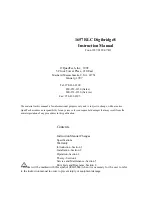
P-(potential, low) = Black/white
I-(current, low) = Black
P+(potential, high) = Red/white
I+(current, high) = Red
Guard = Black/green
2.5.4 The 1688-9600 Extender Cable
("Type 874" Connectors).
The accessory extender cable 1688-9600 can be used to connect a
DUT that is multiterminai, physically large, or otherwise unsuited for the
built-in test fixture. This
low-capacitance cable is used, for example, to connect type-874
connected impedance standards or a special
test fixture. Make connections as follows:
a. Remove the adaptors, if present, from the test fixture.
b. Plug the single-connector end of the extender cable into the
Digibridge test fixture so that its blades enter both slots and the cable lies
away from the display panel. Lock the connector with the two captive
thumb screws.
c. Using the branched end of the cable, connect to the DUT with
careful attention to the following color code.
The cable tips are type 874 coaxial connectors, which
mate with a broad line of components and adaptors.
Notice that the 2 wires with red must connect to the same end of the
DUT, through a coaxial tee if the DUT is a 2-terminal device; the 2
wires labeled with black, connect to the other end, similarly. Connect
the outer (shield) contacts to the shield or case of the DUT only if it
is isolated from both ends of the DUT.
EXTENDER CABLE COLOR CODE
RED AND RED: 1+, current drive to
"high" end of DUT.
RED AND WHITE: P+, potential connection
to same.
BLACK AND BLACK' I-, current return at
DUT "low".
BLACK AND WHITE: P-, potential
connection to same.
OUTER CONTACTS: G, guard connection
to shield or case.
2.6 EXTERNAL BIAS. Figure 2-3.
WARNING
To minimize electrical shock hazard, limit
bias to 30V.
Bias voltage is present at connectors, test
fixtures and on capacitors under test.
Capacitors remain charged after measurement.
Do NOT leave instrument unattended with bias
applied.
Full bias voltage appears on test leads, bias-voltagesource terminals,
and on the leads of the component being measured. Capacitors that have
been charged are dangerous until properly discharged; the user must follow
safe procedures to assure discharge. For safety, all personnel operating the
instrument with bias must be aware of the hazards, follow safe procedures,
and never leave the equipment unattended with bias voltage applied.
2.6.1 Basic Bias Connections.
In order to measure a capacitor with dc bias voltage
applied, connect an external voltage source, as follows:
a. Attach the remote test fixture or an extender cable as described in
paragraph 2.5. Observe the color coding explained there.
INSTALLATION 2-3
Summary of Contents for 1657 RLC Digibridge
Page 6: ...Table of Contents...
Page 8: ...1 2 INTRODUCTION...
Page 9: ...INTRODUCTION 1 3...
Page 10: ...1 4 INTRODUCTION...
Page 15: ...OPERATION 3 1...
Page 24: ...4 2 THEORY...
Page 30: ...5 4 SERVICE...
Page 42: ...5 16 SERVICE...
Page 46: ......
Page 49: ......
Page 50: ......
Page 51: ......
Page 52: ......
Page 53: ......
Page 54: ......
Page 55: ......
Page 56: ......
Page 57: ......














































